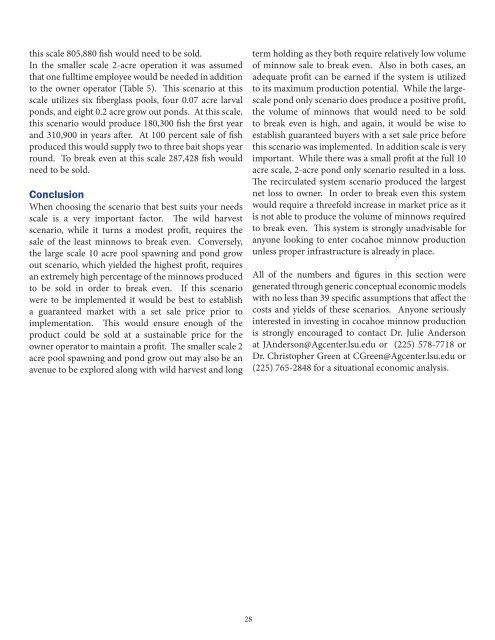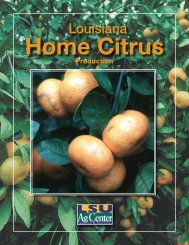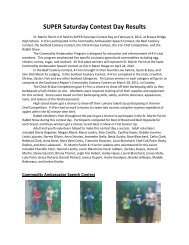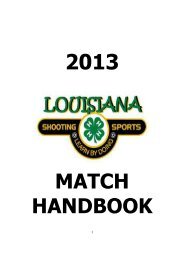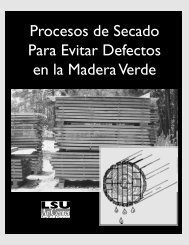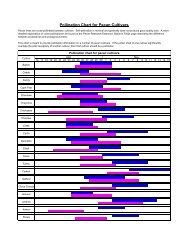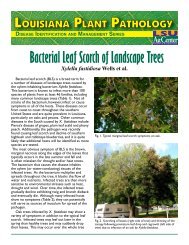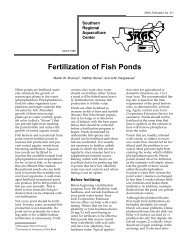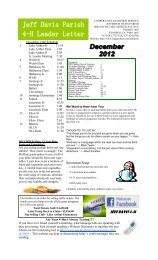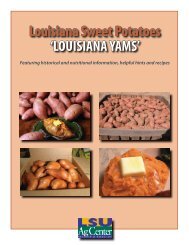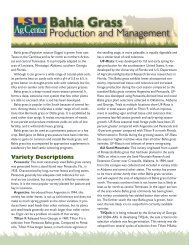Cocahoe Minnow - The LSU AgCenter
Cocahoe Minnow - The LSU AgCenter
Cocahoe Minnow - The LSU AgCenter
You also want an ePaper? Increase the reach of your titles
YUMPU automatically turns print PDFs into web optimized ePapers that Google loves.
this scale 805,880 fish would need to be sold.<br />
In the smaller scale 2-acre operation it was assumed<br />
that one fulltime employee would be needed in addition<br />
to the owner operator (Table 5). This scenario at this<br />
scale utilizes six fiberglass pools, four 0.07 acre larval<br />
ponds, and eight 0.2 acre grow out ponds. At this scale,<br />
this scenario would produce 180,300 fish the first year<br />
and 310,900 in years after. At 100 percent sale of fish<br />
produced this would supply two to three bait shops year<br />
round. To break even at this scale 287,428 fish would<br />
need to be sold.<br />
Conclusion<br />
When choosing the scenario that best suits your needs<br />
scale is a very important factor. <strong>The</strong> wild harvest<br />
scenario, while it turns a modest profit, requires the<br />
sale of the least minnows to break even. Conversely,<br />
the large scale 10 acre pool spawning and pond grow<br />
out scenario, which yielded the highest profit, requires<br />
an extremely high percentage of the minnows produced<br />
to be sold in order to break even. If this scenario<br />
were to be implemented it would be best to establish<br />
a guaranteed market with a set sale price prior to<br />
implementation. This would ensure enough of the<br />
product could be sold at a sustainable price for the<br />
owner operator to maintain a profit. <strong>The</strong> smaller scale 2<br />
acre pool spawning and pond grow out may also be an<br />
avenue to be explored along with wild harvest and long<br />
28<br />
term holding as they both require relatively low volume<br />
of minnow sale to break even. Also in both cases, an<br />
adequate profit can be earned if the system is utilized<br />
to its maximum production potential. While the largescale<br />
pond only scenario does produce a positive profit,<br />
the volume of minnows that would need to be sold<br />
to break even is high, and again, it would be wise to<br />
establish guaranteed buyers with a set sale price before<br />
this scenario was implemented. In addition scale is very<br />
important. While there was a small profit at the full 10<br />
acre scale, 2-acre pond only scenario resulted in a loss.<br />
<strong>The</strong> recirculated system scenario produced the largest<br />
net loss to owner. In order to break even this system<br />
would require a threefold increase in market price as it<br />
is not able to produce the volume of minnows required<br />
to break even. This system is strongly unadvisable for<br />
anyone looking to enter cocahoe minnow production<br />
unless proper infrastructure is already in place.<br />
All of the numbers and figures in this section were<br />
generated through generic conceptual economic models<br />
with no less than 39 specific assumptions that affect the<br />
costs and yields of these scenarios. Anyone seriously<br />
interested in investing in cocahoe minnow production<br />
is strongly encouraged to contact Dr. Julie Anderson<br />
at JAnderson@Agcenter.lsu.edu or (225) 578-7718 or<br />
Dr. Christopher Green at CGreen@Agcenter.lsu.edu or<br />
(225) 765-2848 for a situational economic analysis.


